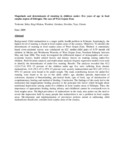| dc.description.abstract | Background: Child malnutrition is a major public health problem in Ethiopia. Surprisingly, the highest level of stunting is found in food surplus areas of the country.
Objective: To identify the determinants of stunting in food surplus areas of West Gojam Zone. Method: A community based cross-sectional survey was conducted on 622 mother-child pairs of 0-59 month old children in Mecha and Wenberma Woredas of West Gojam Zone, Northern Ethiopia between May and June 2006. The study investigated the differential impact of demographic and socio-economic factors, health related factors and dietary factors on stunting among under-five children. Both bivariate analysis and multivariate analysis (logistic regression model) were used to identify the determinants of under-five stunting. Results: The analyses revealed that 43.2 (12.0-17.6) 95% CI percent of the children under age five were suffering from chronic malnutrition, 14.8 (39.3-47.1) 95% CI percent were acutely malnourished and 49.2 (45.3-53.1) 95% CI
percent were found to be under-weight. The main contributing factors for under-five stunting were found to be sex of the child, child’s age, diarrhea episode, deprivation of colostrum, duration of breastfeeding, pre-lacteal feeds, type of food, age of introduction of complementary feeding and method of feeding. Conclusion: The findings of this study led to the realization that inappropriate feeding practice is the principal risk factor which brought about nutritional deprivation among under-five children in food surplus areas of Ethiopia. Thus, the importance of appropriate feeding during infancy and childhood cannot be overstated even in food surplus areas. The high prevalence of malnutrition in the study area points out the need to revisit the impression held by many people
that malnutrition is not a problem in food surplus areas. Development and implementation of preventive policies aimed at addressing child malnutrition should also consider food surplus areas of the country. | en |

